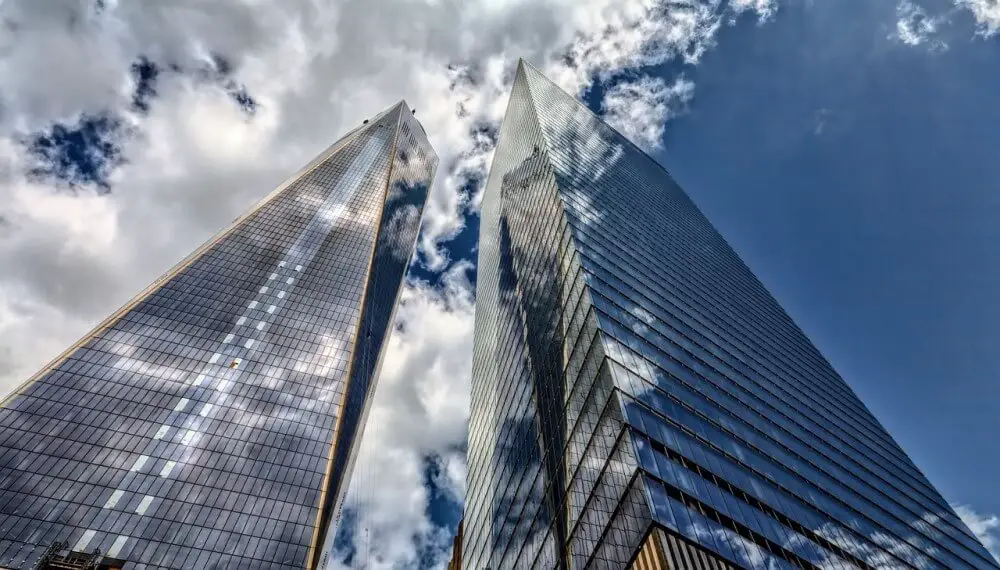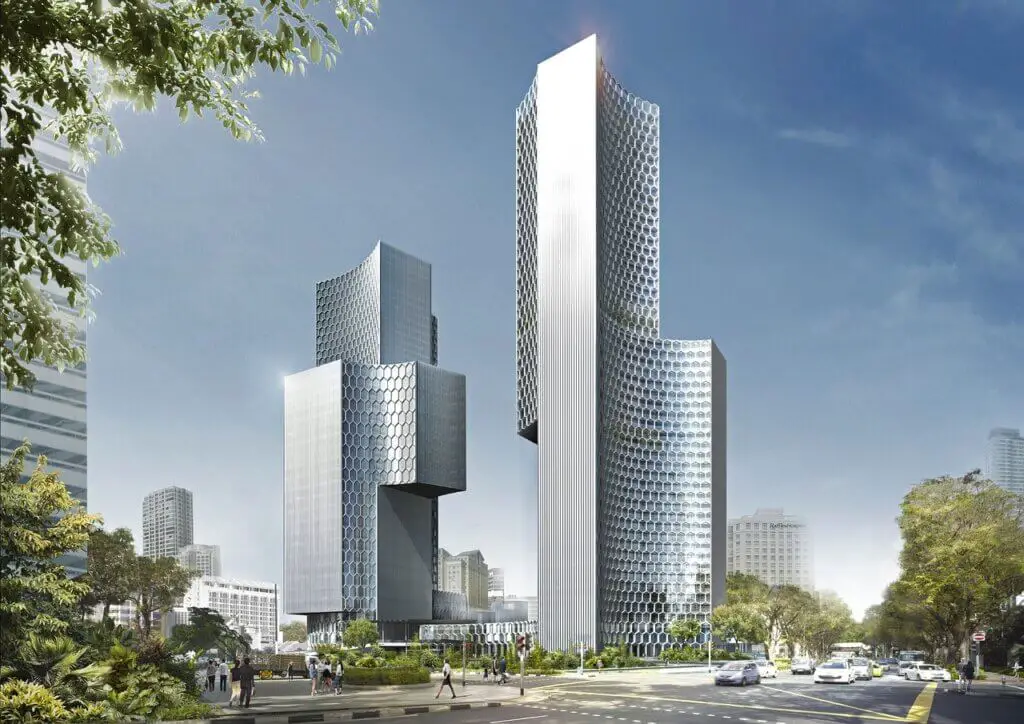Across most of the world’s biggest cities, skyscrapers of all shapes and sizes dot the skyline. They are structures that symbolise the modernity and dynamism of modern urban centres.
And, part of the reason why skyscrapers are considered in such a light is their name. After all, not all buildings ‘scrape’ the sky in the same way skyscrapers do, and this label separates them from all other structures.
So,with this considered, let’s put an answer to the question: why is a skyscraper called a skyscraper?
Skyscrapers are called skyscrapers primarily due to their characteristics as the tallest buildings in an urban area. In a figurative sense, they are so tall that, from ground level, they look as if they ‘scrape’ the sky. However, skyscrapers are named skyscrapers for other reasons as well. These include increased marketability and the spirit of innovation in which skyscrapers were first built.
Read on to find out the full meaning behind the word skyscraper, where the word ‘skyscraper’ came from in the first place, and more interesting information about skyscrapers themselves.
But first, let’s explore the reasons why skyscrapers are called skyscrapers further:
Reason 1: The height of a skyscraper
The first, and perhaps most obvious, reason why a skyscraper is called a skyscraper is due to their lofty characteristics. Starting in the late 19th Century, buildings started to be built that stood high and tall over the rest of their city, thanks to advancements in construction technology.
Eventually, these buildings reached such heights that they virtually ‘scraped’ the sky, leading to the invention of the term ‘skyscraper’. This term became increasingly popular after this, and was soon used to label any building that exceeded a particular height.
We now typically describe a building as a skyscraper if it has a vertical height of 100 metres, or 328 feet. Of course, across the world, there are now other buildings that far exceed this height, with towers reaching hundreds of metres into the air. The tallest building in the world, the Burj Khalifa, is a staggering 828 metres tall.
Other terms, such as megatalls and supertalls, have come to accommodate the tallest of modern buildings. But, the term skyscraper is still used commonly throughout the world as a blanket term for buildings which are too tall to be described as a mere ‘high-rise’.
Reason 2: The original usage of ‘skyscraper’
In modern society, we firmly associate the term ‘skyscraper’ with tall buildings. However, this was not always the case – in fact, in its original form, the word was once used for a lot of things besides buildings.
It was used to describe anything that was renowned to be particularly tall. For example, it was commonplace, to call sails on a ship skyscrapers, if they were so high they looked like they ‘scraped the sky’. You may have even referred to a human as a skyscraper!
Then, toward the back end of the 19th Century, ‘skyscraper’ was then used to describe the newly possible tall buildings that had the same sky scraping effect.
The first building to be designated as a ‘skyscraper’ was the Home Insurance Building in Chicago, upon its completion in 1885. This proved particularly popular, which meant that, as more and more buildings grew taller, the definition of a skyscraper became more closely linked to these structures.
But, they would never have been called skyscrapers in the first place had there not already been a popularised term that people associated with objects scaling grand heights. So, the original usage of the term skyscraper is one of the reasons why tall buildings are called skyscrapers today.

Reason 3: The spirit of innovation
Another reason why skyscrapers are called skyscrapers is the pioneering spirit of innovation that has always accompanied their construction. From the first time skyscrapers appeared on the skylines of the world, they were seen as bold and boundary-pushing feats of architecture.
In many ways, skyscrapers were a visual representation of the technological advancements that were occurring at the time. And, ever since then, skyscrapers have risen higher and higher, and have been responsible for countless engineering and building innovations.
Taking the term ‘skyscraper’ in mind, we can apply the same thinking: that these new tall buildings were reaching, or ‘scraping’, society’s technological horizons. In essence, labelling buildings as skyscrapers helped to convey this sense of innovation and present these structures as trend-setting buildings of the future.
Reason 4: Marketability
Due to their association with wealth, power and ambition, skyscrapers have always had a certain appeal. After all, they are frequently the places where some of the biggest banks and corporations in the world conduct business, and where some of the richest people in the world reside.
From a different angle, some especially iconic skyscrapers have also come to serve as symbols of a city or a community. Think of the Empire State Building and its relationship to New York City, for example.
Property developers know about this, and can use it to their advantage. They have long applied the promotional tag of ‘skyscraper’ to any new building that reaches a decently tall height, sometimes even regardless of whether it is taller than 100 metres.
Their desire, of course, is to make their buildings appear desirable to live and work in – something which would help ensure high occupancy rates and keep investors happy.

What is the definition of the word ‘skyscraper’?
A skyscraper can be defined as an especially tall building that features multiple floors used for a variety of purposes, i.e. residential or commercial. They are typically found in dense urban areas, with the biggest cities in the world usually containing multiple skyscrapers.
While there is no specific threshold for how tall a building has to be for it to be considered a skyscraper, a rough guideline is around 100 metres. However, as buildings have grown taller and taller, ‘supertall’ and ‘megatall’ are now more frequently used to describe the world’s tallest buildings.
Ever since they were first constructed in 1885, skyscrapers have been considered some of the world’s greatest architectural and civil engineering feats. In some cases, they have even become emblematic of a city and widely-visited tourist attractions in their own right.
While there has been some controversy surrounding the construction of skyscrapers and their impact on their surrounding environment, there is no doubt they will continue to be constructed in urban areas around the world for the foreseeable future.
Where does the word ‘skyscraper’ come from?
The word ‘skyscraper’ has its origins with the Old Norse word ‘skrapa’, which translates in English as ‘erase’. In essence, the word skyscraper refers to something being so tall that it ‘scrapes’ the sky – in other words, obscuring it from vision.
Although it is not clear exactly where the term skyscraper originated in reference to a tall building, the first confirmed example was in the February 25 1883 edition of The Chicago Daily newspaper. This referred to the term ‘skyscraper’ as part of a wave of high-rise construction in the city at the time.
However, there are some who have suggested that the word skyscraper may have actually come not from Chicago, or even North America, at all. Instead, they believe that the term stemmed from the Far East, where the term ‘sky piercer’ was historically used to describe tall buildings.
We hope you have enjoyed our comprehensive guide to why skyscrapers are called skyscrapers. While we don’t know exactly who was responsible for the coining of the term, we do know we’ll be hearing it for some time yet.
While you’re here, why not check out some more in-depth guides to why certain building terms exist. For instance, explore why a building is called a building, and why an airport is called an airport.
Or, if you’d like more definitions on building and architecture vocabulary, take a look at our range of building wikis.
Last Updated on 24 March 2023 by Michael
